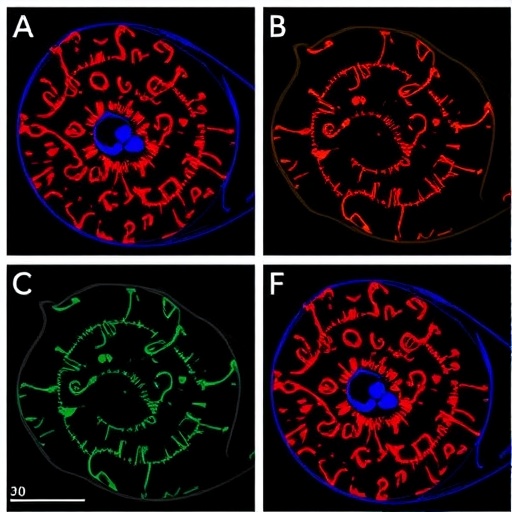Recent advancements in cancer research have yet again illuminated the complex world of molecular interactions that drive tumorigenesis. With a growing emphasis on the regulatory roles of non-coding RNAs, a particular study has cast a spotlight on FOXD3-AS1, a long non-coding RNA (lncRNA), and its involvement in prostate cancer. Researchers Yu, Liu, and Wen have unveiled compelling evidence that knocking down FOXD3-AS1 can significantly inhibit the growth and progression of prostate cancer cells. Their findings point towards a novel therapeutic target that could change the landscape of treatment for this malignant condition.
Prostate cancer remains one of the most prevalent forms of cancer among men worldwide. The challenge with treating this type of cancer lies in its heterogeneous nature and the intricate molecular pathways that contribute to its development and metastasis. In their study, the researchers explored how FOXD3-AS1 interacts with various molecular players, particularly miR-491-5p, to influence cancer cell behavior. The intricate balance that exists between these molecules reveals a potential point of intervention in cancer therapy.
The researchers employed a series of in vitro experiments to dissect the role of FOXD3-AS1 in prostate cancer. By strategically silencing the lncRNA, they observed not only a reduction in cell proliferation but also an increase in apoptosis—a process that is often dysregulated in cancer. This finding is especially significant; enhancing apoptosis in cancer cells can lead to more efficient tumor regression. The study highlights the potential of targeting such non-coding RNAs in designing new therapeutic strategies.
Moreover, the interplay between FOXD3-AS1 and miR-491-5p forms a crucial axis in driving prostate cancer progression. MicroRNAs (miRNAs) serve as critical post-transcriptional regulators in various biological processes, including cell growth, differentiation, and apoptosis. In their study, Yu and colleagues provided evidence that FOXD3-AS1 could act as a sponge for miR-491-5p, effectively sequestering it and thereby reducing its regulatory control over downstream targets like PEG10. The implications of this interaction are profound, suggesting that disrupting FOXD3-AS1 could restore the function of miR-491-5p, ultimately inhibiting tumor growth.
PEG10, a gene that has been implicated in various cancers, including prostate cancer, appears to play a significant role in promoting cell proliferation and survival. The findings from the study suggest that the depletion of FOXD3-AS1 leads to increased levels of miR-491-5p, which subsequently suppresses PEG10 expression. This mechanism highlights a potential therapeutic path where restoring miR-491-5p levels could be beneficial in countering the aggressive behavior of prostate cancer cells.
The data presented by the research team extends beyond basic biology. Their functional assays demonstrate that FOXD3-AS1 is not merely a bystander in cancer progression but a pivotal regulator of several oncogenic pathways. In various experimental setups, they documented that cells with decreased FOXD3-AS1 exhibited lower migration and invasion capabilities, aligning with the notion that lncRNAs can influence metastasis. This finding emphasizes the importance of exploring lncRNAs not just as molecular markers but as active regulators in cancer biology.
The therapeutic implications of this study are significant. Current treatments for prostate cancer, such as androgen deprivation therapy and chemotherapy, often encounter resistance, making novel targets essential for improving patient outcomes. The study’s findings propose that targeting FOXD3-AS1 could sensitize cancer cells to existing therapies or serve as a standalone treatment option, thereby providing new hope in the battle against prostate cancer.
Furthermore, the research underscores the necessity of developing drug delivery systems that can effectively target lncRNAs like FOXD3-AS1. Advances in nanotechnology and molecular biology offer promising avenues for creating therapies that can selectively silence harmful lncRNAs while minimizing off-target effects. A tailored approach that considers the patient’s unique genetic makeup will be crucial in the era of precision medicine.
As investigations continue, the potential of combining lncRNA silencing with other therapeutic strategies appears promising. Integrating FOXD3-AS1 knockdown with immunotherapy or newer targeted therapies could forge pathways to improved survival rates and quality of life for patients battling prostate cancer. This multifaceted approach aligns with the evolving understanding that cancer is not just a single disease but rather an amalgamation of distinct yet interconnected pathways.
In conclusion, the research conducted by Yu, Liu, and Wen opens an exciting new chapter in prostate cancer research. By focusing on the role of the lncRNA FOXD3-AS1, the study not only elucidates its function in the progression of prostate cancer but also heralds the potential for innovative therapies that could one day transform patient management. This work exemplifies the critical need to explore the intricate networks that govern cancer biology, paving the way for breakthroughs that could significantly enhance the lives of those affected by this disease.
As the scientific community continues to unveil the mysteries surrounding non-coding RNAs and their implications in cancer, it is evident that further research is essential to realize the clinical potential of these molecular players. The journey from bench to bedside is fraught with challenges, but the promise that lncRNAs such as FOXD3-AS1 hold cannot be overstated. The hope is that by continuing to unravel these complex interactions, we may soon see a paradigm shift in how we understand and treat prostate cancer in years to come.
Subject of Research: The role of FOXD3-AS1 in prostate cancer progression through interaction with miR-491-5p and PEG10.
Article Title: Knockdown of FOXD3-AS1 inhibits the progression of prostate cancer by targeting miR-491-5p/PEG10.
Article References: Yu, Y., Liu, Q. & Wen, Y. Knockdown of FOXD3-AS1 inhibits the progression of prostate cancer by targeting miR-491-5p/PEG10. J Cancer Res Clin Oncol 151, 329 (2025). https://doi.org/10.1007/s00432-025-06364-x
Image Credits: AI Generated
DOI: https://doi.org/10.1007/s00432-025-06364-x
Keywords: FOXD3-AS1, prostate cancer, miR-491-5p, PEG10, lncRNA, cancer therapy.
Tags: cancer cell behavior regulationcancer research breakthroughsFOXD3-AS1 in prostate cancerin vitro experiments in oncologylong non-coding RNA therapeutic targetsmiR-491-5p and prostate cancermolecular interactions in cancernon-coding RNA research advancementsprostate cancer progression inhibitionprostate cancer treatment challengessilencing FOXD3-AS1 effectstumorigenesis and lncRNA





